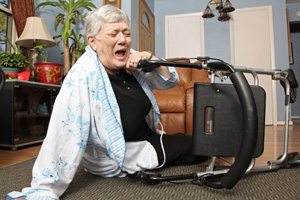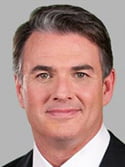Nursing Home Fall Injuries Lawyer
 Falls in the elderly can have serious consequences. Many falls at nursing homes are avoidable or preventable. In fact, the Wisconsin Nursing Homes and Residents annual report shows that 24% of nursing home residents have fallen in the past 30 days, and 26% had fallen in the past 31 days to 180 days.
Falls in the elderly can have serious consequences. Many falls at nursing homes are avoidable or preventable. In fact, the Wisconsin Nursing Homes and Residents annual report shows that 24% of nursing home residents have fallen in the past 30 days, and 26% had fallen in the past 31 days to 180 days.
Residents die as a result of fractures and brain injuries caused by a fall. The mortality rate from a hip fracture is significant.
Has your loved one been injured in a fall at a nursing home?
The nursing home and its staff must focus on minimizing fall risk and risk of fall-related injuries while maximizing individual dignity, freedom, and quality of life.
At the law offices of PKSD, our personal injury lawyers have represented numerous residents and their loved ones for injuries and wrongful death from a fall. Our clients have suffered hip fractures, leg fractures, neck fractures and subdural hematomas. Sadly, all of their falls were preventable.
Contact our Wisconsin nursing home abuse lawyers today and learn more about your legal options. Call us toll free at 414-333-3333 or click “here” to reach us online 24 hours a day.
We proudly offer free consultations and we only get paid when we obtain a recovery on your claim.
Complications After a Fall
What some may not realize is that the fall itself is not always the culprit. Instead, the fall is the catalyst for numerous other complications that can deteriorate the residents health and even be fatal. Falls are complex, preventable events with multiple causes and consequences. The nursing home has a responsibility to identify and assess the residents risk for falls.
… up to 20% of patients die within a year following their injury…
Falls may trigger pneumonia, depression, infection and/or muscle loss. Falls are likely to lead to fractures and immobility, putting the resident at risk for pressure sores. A fall can also trigger a psychological response that prevents people from becoming mobile and active again. Immobility can prevent a resident from taking deep breaths, making him or her more prone to pneumonia as well as skin breakdown, pressure sores, bladder infection and lung infection.
Mortality following hip fracture is high – up to 20% of patients die within a year following their injury. Those who survive often experience significant disability and diminished quality of life. According to the Injury Center on the Center for Disease Control and Prevention website, there are about 1,800 fatal falls in U.S. nursing homes each year.
Falls and Bedrail Injuries
State law requires a written doctors order for the use of bedrails to restrain a nursing home resident. Oftentimes, the use of bedrails isn’t questioned and orders are not obtained because people mistakenly believe that the bedrails are either an effective safety device or that they pose no harm. Bed rails are dangerous. Residents can die due to asphyxiation and strangulation.
The most common injury suffered by nursing home residents enclosed by bedrails occurs when a nursing home resident climbs over the rails and falls to the floor. This type of fall increases the risk of a more significant injury because when people climb over their bedrails and fall, the height of the fall is greater than if they would’ve fallen from a bed without rails.
The FDA and Hospital Bed Safety Work Group have published warnings about bed rail use.
Preventing Falls
Wisconsin currently ranks second in the nation in fall deaths and is consistently among the highest states for fall deaths. Proper intervention can significantly reduce the rate of injuries and deaths due to nursing home falls. Studies show that implementing a fall prevention program reduces the risk of falls by 19%. Many of the interventions are low tech and low cost.
Residents at risk for falls should be monitored closely and receive assistance during transfers to prevent them from falling.
Effective interventions include:
- Proper assessments of residents to address risk factors and to treat underlying medical conditions.
- Physical therapy, gait training, walking programs and strength building.
- Environmental modifications including placing grab bars in bathrooms, raising toilet seats, lowering bed heights and installing handrails in hallways.
- Minimizing the use of medications including psychoactive drugs that have side effects that cause dizziness and decreased balance.
- Placing call bells in reach of the resident and training the resident to ask for assistance when getting out of bed.
- Providing enough staff to assist residents in getting out of bed, walking and toileting.
- Training the staff in fall prevention.
- Alarms, motion sensors, low bed, mats, hoyer lifts, non-skid footwear and sitters can all be used as well.
Developing a Proper Care Plan
Care planning is critical to preventing nursing home injuries. All nursing homes have an obligation to conduct a complete assessment of the patient upon admission to the facility. A portion of that assessment evaluates the residents risk of falling.
Following the evaluation, the nursing home must prepare a care plan to address fall prevention. A proper care plan should address the use of safety devices, and it should address the type of assistance the resident needs getting out of bed, walking and toileting.
While it is critical for the nursing home to develop a proper care plan, the care plan is only useful if it is consistently followed. That means the staff must be properly trained and there must be sufficient staffing to carry out the care plan. Failure to implement and carry out a care plan is negligence and may be the basis for a lawsuit.
Contact our Wisconsin Nursing Home Abuse Attorneys
 If you or your loved one is the victim of any type of nursing home abuse or neglect, you must contact an experienced Wisconsin personal injury attorney, nursing home attorney to protect your rights and make sure you receive compensation for harm suffered at the nursing home.
If you or your loved one is the victim of any type of nursing home abuse or neglect, you must contact an experienced Wisconsin personal injury attorney, nursing home attorney to protect your rights and make sure you receive compensation for harm suffered at the nursing home.
Taking legal action against an abusive or negligent nursing home is one of the best ways to raise awareness, improve quality of care and effectively improve the life of your loved one and other victims of nursing home abuse/negligence.
At PKSD, we are dedicated to preventing negligence and abuse from occurring in nursing homes. Our Wisconsin nursing home negligence attorneys are experts in this complicated area of the law, and work relentlessly to hold nursing homes accountable.
Our team of attorneys, paralegals and nurses handles the largest volume of nursing home cases in Wisconsin. Our team helps clients and their families obtain financial restitution for their pain, suffering, financial loss and medical expenses. We provide each client with extensive resources, aggressive representation, personalized attention and compassionate legal care.
If you are in need of a Wisconsin nursing home attorney, contact Pitman, Kalkhoff, Sicula & Dentice, S.C. today for your free consultation at 414-333-3333 .






